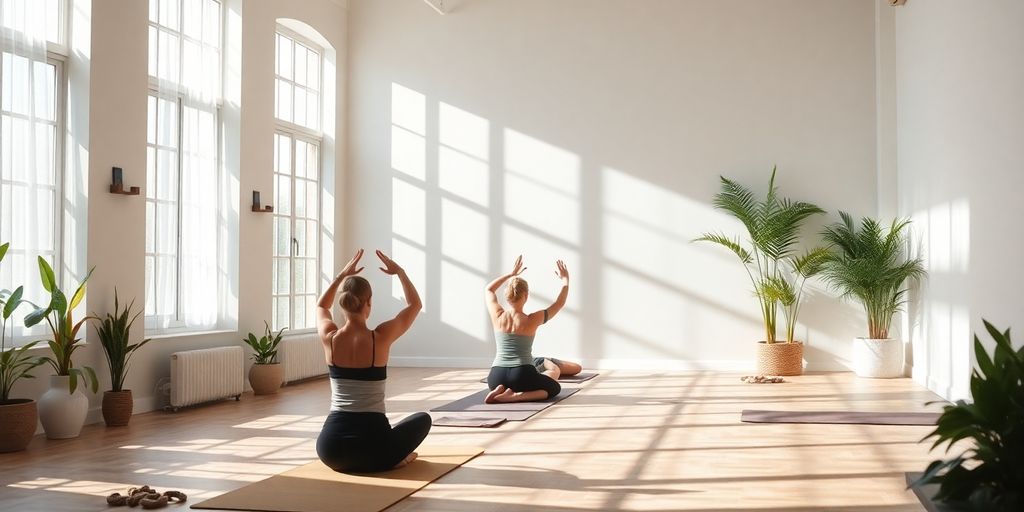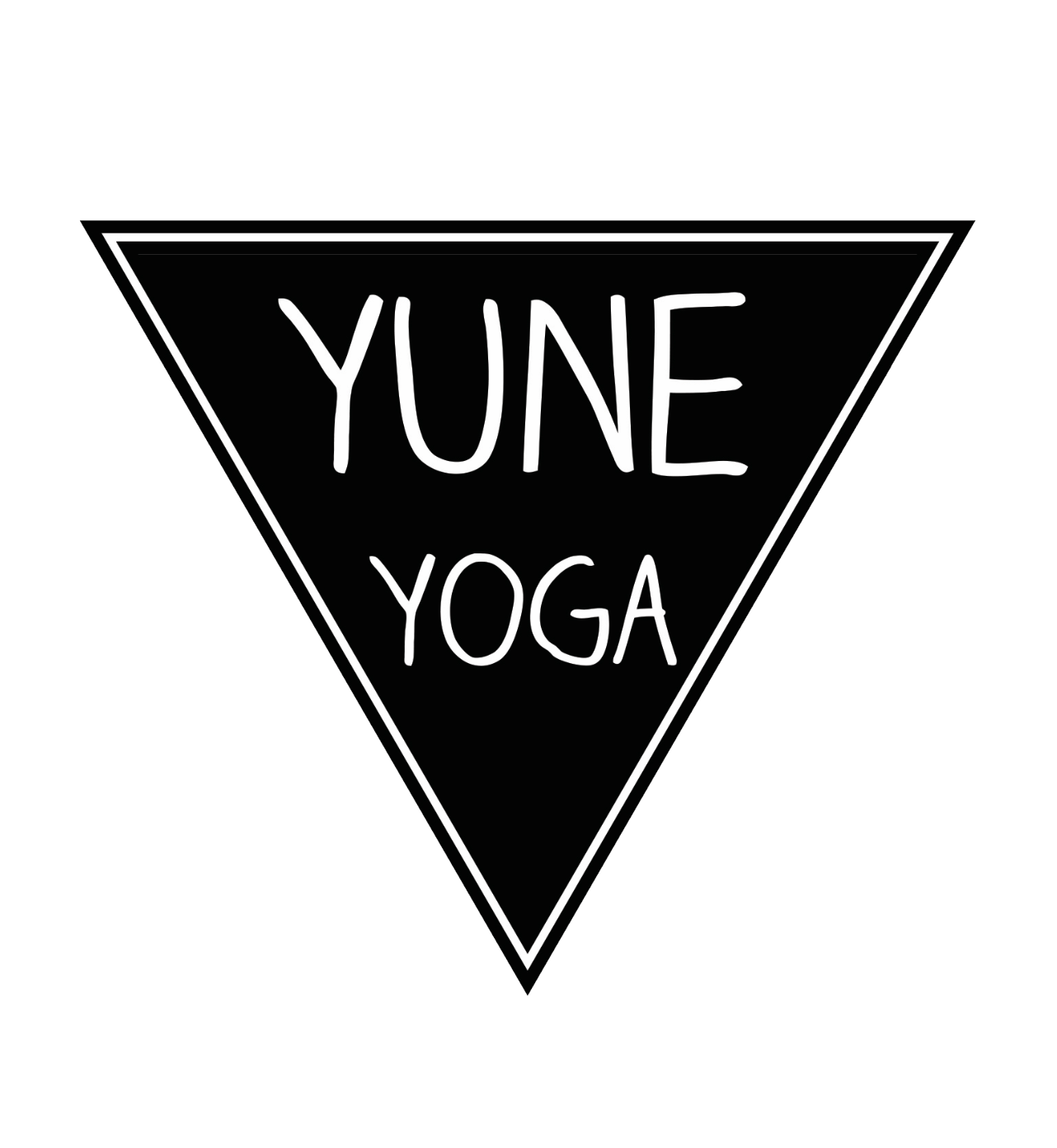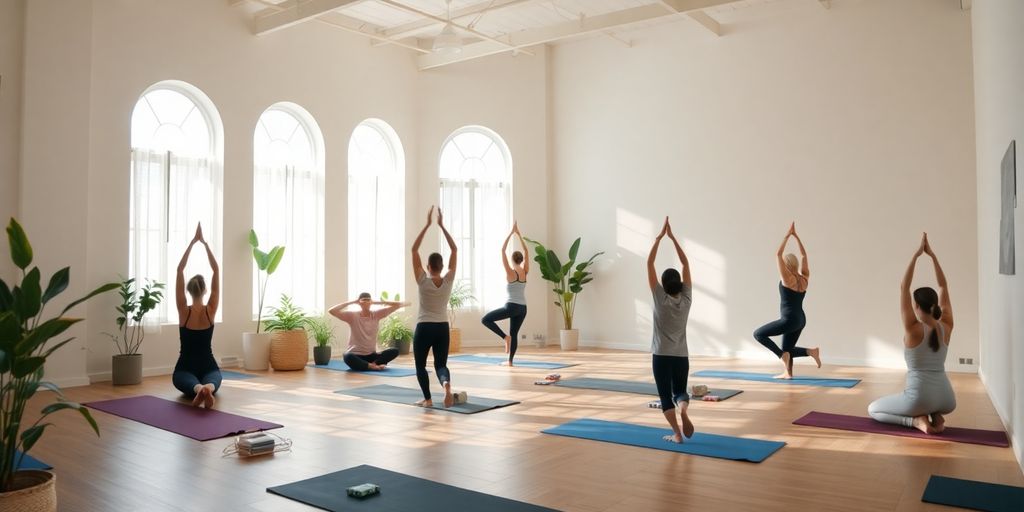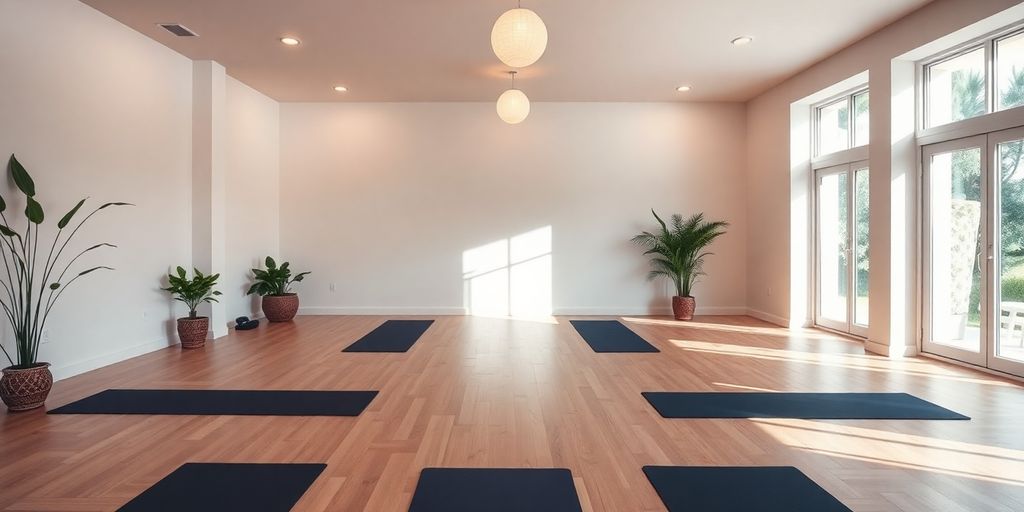
Exploring Wellness: The Transformative Journey Beyond Hot Yoga
In the quest for wellness, many people find themselves drawn to hot yoga. While it offers numerous benefits, there’s a whole world of wellness practices that can complement or even surpass the experience found in a heated studio. This article explores various approaches to holistic health that go beyond hot yoga, emphasizing the importance of community, personal growth, and a balanced lifestyle.
Key Takeaways
- Wellness is a holistic journey that includes mind, body, and spirit.
- Mindfulness practices, such as meditation, can enhance overall well-being.
- Connecting with nature can provide significant mental health benefits.
- Building a supportive community can foster personal growth and resilience.
- Nutrition plays a vital role in maintaining energy and mood.
The Essence of Wellness Beyond Hot Yoga

Understanding Holistic Health
When it comes to wellness, it's not just about working out hard in a heated room. Holistic health is about caring for the mind, body, and soul all at once. Real well-being means treating your entire self as connected, not in parts.
Here’s a simple list of what many people find important in a balanced life:
- Physical strength and flexibility
- Emotional balance and calmness
- Mental clarity and focus
To help break it down, consider this table:
| Aspect | What It Brings |
|---|---|
| Physical | Endurance, balance, energy |
| Emotional | Calm, stress relief |
| Mental | Focus, clarity |
The idea is to let these parts support each other, making life feel just a bit more in tune, no matter if you're on the mat or off it.
The Role of Mindfulness
Mindfulness isn't just for meditation—it’s a way to settle your thoughts when everyday life feels chaotic. It helps you slow down and notice the little shifts in your mood and ideas.
Mindfulness practice brings a refreshing pause, allowing the mind and heart to work together even during tough days.
If you want to try making mindfulness part of your routine, start with these steps:
- Focus on your breathing during quiet moments.
- Notice your surroundings without judgment.
- Give yourself time to just be present.
Sometimes, a little nudge like checking out a quick Cloudflare security note can remind you to keep security and calm in sight, even in our digital world.
Integrating Body and Spirit
Merging physical exertion with a sense of inner calm can be a game changer. This isn’t about fancy poses or feeling perfect all the time; it's more about finding small ways to connect your daily movements with your deeper self.
Consider some straightforward ways to blend the two:
- Take a few extra minutes after exercise to reflect silently.
- Try a slow, mindful stretching session where you focus on how each muscle feels.
- Keep a simple journal to track physical efforts and emotional responses.
By pairing physical activity with mental check-ins, you create a routine that nudges both body and spirit toward a balanced, healthier life.
Exploring Alternative Practices
Meditation Techniques
Meditation is one way to clear a busy mind. There are different methods for calming your thoughts, and sometimes even a simple moment of quiet can change your day. Here’s a brief list for starting out:
- Find a quiet spot to sit.
- Use a timer and start with just a few minutes.
- Follow a simple guided session, like yoga insights.
Sometimes, a few minutes is all it takes for your mind to relax and feel a bit lighter.
Breathwork and Its Benefits
Breathwork involves focusing on your breathing to change how your body feels. It sounds simple but can make a big difference when you’re feeling stressed. Here’s a table breaking down some common techniques:
| Technique | Duration | Benefit |
|---|---|---|
| Box Breathing | 2-3 mins | Calms nerves |
| Alternate Nostril | 5 mins | Balances energy |
| Deep Breathing | 3-4 mins | Reduces tension |
Using these methods, you might notice a change in your day-to-day energy levels. Give one a try the next time you need a break.
Nature Immersion
Nature immersion is about stepping outside and reconnecting. Whether it’s a walk in the park or a few minutes of sitting by a tree, let the outdoors help reset your mind.
Spending time outdoors can feel like a gentle reminder to slow down and breathe, replacing daily stress with simpler, more natural rhythms.
Taking a moment for nature might be just what you need to refresh your outlook.
The Journey of Personal Growth
Self-Discovery Through Movement
When you start moving in ways that feel natural, you begin to see parts of yourself you never really noticed before. Every stretch, every step can reveal a new layer. It’s like you’re putting together a puzzle—one piece at a time. Sometimes, a simple walk or a slow pace might help you connect with feelings deep down that you’ve kept hidden. Exploring movement at your own speed can be a powerful way to learn who you truly are.
Emotional Resilience
Working on your emotional strength is a process that happens gradually. It isn’t always simple, but everyday efforts add up, and even the tough moments can start to feel a bit lighter. Here are a few ideas that might help:
- Keeping a small diary of your feelings
- Embracing minor physical challenges even when you're tired
- Mixing up your routine with fresh exercises
For quick reference, check out the summary below:
| Aspect | Description |
|---|---|
| Self-Awareness | Noticing what your body and feelings are telling you |
| Stress Handling | Finding simple ways to calm down during hard times |
| Growth Steps | Small changes that build up day by day |
Setting Intentions for Change
This part is about deciding exactly what you want to change in your life. Maybe it’s tweaking your movement routine or adopting a new habit. Start small: think it over, jot down a clear goal, and move at a pace that feels right. Sometimes, setting this intention is like giving yourself a map for the road ahead.
Growth comes from challenging yourself and letting your movement tell your story.
Sometimes, letting go of old patterns clears the way for a new start. Even when it’s messy, every little action counts.
The whole journey is personal and, at times, a bit unpredictable. Just remember to check in with your heart and mind, and make some space for simple self care along the way.
Nutrition and Wellness Synergy
When you begin to see how what you eat connects to how you feel, things start to make sense. Nutrition is not just about fueling your body; it's about supporting every aspect of your wellness. This journey goes beyond counting calories—it’s about eating to support energy, mood, and overall balance.
Eating for Energy
Food is the fuel that helps you get through the day. Focusing on meals that provide slow, steady energy can change how you feel from morning until night. Nutrition plays a clear role in fueling your body and mind. In fact, a well-balanced breakfast or snack—even something as simple as whole grains combined with protein—can make a big difference. Here are a few simple tips to keep energy levels up:
- Start your day with a mix of whole grains and fruit.
- Include lean protein in your meals and snacks.
- Keep a water bottle handy throughout the day.
A quick reference table to illustrate some typical energy-boosting foods:
| Food Category | Energy Boost | Example |
|---|---|---|
| Whole Grains | Steady release | Oatmeal |
| Lean Protein | Muscle repair | Chicken, tofu |
| Fresh Produce | Vitamins & fiber | Apples, spinach |
Sometimes, a little extra boost works like a secure checkpoint—think of it as adding a layer of Cloudflare security to your day.
Mindful Eating Practices
Taking time to enjoy your food can change the whole eating experience. Slowing down and really savoring every bite ensures that eating becomes a part of your wellness routine. Here are some ideas to help you practice mindfulness while eating:
- Chew slowly and enjoy the textures and flavors.
- Set aside distractions during your meals.
- Reflect on where your food came from and the effort behind it.
Paying attention during meals may not fix everything, but it often leads to small changes that add up over time.
The Impact of Nutrition on Mood
What you eat can have a real impact on how you feel. Foods may help keep your mood steadier, reducing the ups and downs that can come from erratic eating habits. By choosing ingredients that support brain health, you might notice a more balanced mood throughout the day. Consider these steps when planning your meals:
- Opt for seasonal fruits and vegetables to get fresh nutrients.
- Reduce heavy, processed items that can cause sugar spikes.
- Enjoy a mix of proteins, fats, and carbs to keep your brain happy.
To give a quick look at some nutrients that influence mood, check out this table:
| Nutrient | Impact on Mood | Sources |
|---|---|---|
| Omega-3 fatty acids | Supports brain health | Fish, walnuts |
| B Vitamins | Helps balance energy | Leafy greens, eggs |
| Magnesium | Promotes calm and sleep | Nuts, legumes |
By embracing these nutrition practices, you'll start to see a clearer link between your diet and overall wellness.
The Importance of Rest and Recovery
Taking time off isn’t a luxury; it’s a part of staying healthy overall. Our bodies and minds need breaks to avoid feeling worn out by everyday pressures. Rest and recovery go hand in hand with any active routine, keeping you balanced and grounded. Every now and then, it helps to check in with your personal security measures to ensure you’re keeping an eye on what matters.
Understanding Burnout
Burnout happens when you push yourself too hard without the chance to relax. It can sneak up on anyone, leaving you tired and unfocused. Listening to your body and mind is key. When you feel overwhelmed, it’s a signal to step back and regain control over your daily schedule.
Techniques for Effective Recovery
Recovering well means mixing various activities that calm both your body and your thoughts. Here are some ideas:
- Take a quiet walk. Sometimes a short stroll outside can reset your energy.
- Stretch gently to keep your muscles loose.
- Try a few minutes of mindful breathing to clear your head.
A simple table can help plan your recovery routine:
| Activity | Duration | Benefit |
|---|---|---|
| Sleep | 7-9 hours | Restores energy and mood |
| Stretching | 10-15 minutes | Loosens muscles and joints |
| Meditation | 5-10 minutes | Calms the mind and reduces stress |
Remember: Taking time to restore yourself is as important as any workout. Listen to your body, allow regular breaks, and enjoy the simplicity of slowing down.
The Role of Sleep in Wellness
Sleep is the reset button that your body needs. It helps clear your mind and gives you the energy to handle daily tasks. A few points to consider about sleep:
- Routine matters. Going to bed and waking up at the same time can help set your body’s internal clock.
- A comfortable bed and a quiet space are simple tools to boost your quality of sleep.
- Less screen time before bed might lead to a smoother transition to sleep.
By paying attention to both rest and sleep, you build a stronger foundation for your overall wellness journey.
Embracing a Balanced Lifestyle

Finding Your Unique Path
Everyone's journey is different, and finding your unique path means trying different things and seeing what works. Sometimes you'll stumble upon ideas that feel just right. Even small steps can lead to surprising changes. For instance, a friend of mine recently switched up his routine and found new energy in his daily walk. Along the way, you might want to check out Cloudflare security for a nudge in organizing your digital life, which can free up time for more personal pursuits.
Incorporating Variety in Practice
A mixed routine helps keep things interesting. Changing up your activities can prevent boredom and keep you on your toes. Here are a few ways to mix things up:
- Try different types of exercise like light cardio, stretching, and muscle strengthening.
- Rotate your daily activities. One day might be yoga, another a brisk walk, then perhaps a dance class.
- Change your environment; sometimes exercising outdoors can be energizing.
Additionally, consider evaluating your schedule using a simple table for guidance:
| Practice Type | Time (minutes) |
|---|---|
| Stretching | 15 |
| Light Cardio | 20 |
| Strength Training | 25 |
These numbers are suggestions and can be adjusted to fit your pace.
Sustaining Long-Term Wellness
Keeping up a balanced lifestyle requires planning and commitment. A small daily effort can transform the way you feel over time.
Here are some straightforward steps to help keep a steady path:
- Establish a simple routine that fits your daily life.
- Check in with yourself at the end of the day and note any small wins or areas to adjust.
- Allow for rest days so your body never gets overwhelmed.
It’s often the little adjustments in your everyday routine that grow into lasting habits. Take the time to listen to your body and mind, and let each day guide you gently forward.
Wrapping Up the Hot Yoga Experience
In the end, hot yoga is more than just a workout; it’s a journey that can change your life. It challenges you physically and mentally, pushing you to grow in ways you might not expect. Whether you’re looking to relieve stress, improve your health, or just find a community, hot yoga has something to offer. It’s about finding balance and peace in a hectic world. So, if you’re curious about what hot yoga can do for you, why not give it a shot? You might just discover a new passion that helps you feel better inside and out.
Frequently Asked Questions
What is wellness beyond hot yoga?
Wellness beyond hot yoga includes practices like meditation, mindfulness, and balanced nutrition that help improve both mental and physical health.
How can mindfulness improve my wellness journey?
Mindfulness helps you focus on the present moment, which can reduce stress and increase your overall happiness.
What are some alternative wellness practices?
Some alternative practices include meditation, breathwork, and spending time in nature.
How does community support impact wellness?
Being part of a supportive community can motivate you, provide encouragement, and help you feel connected to others.
Why is nutrition important for overall wellness?
Good nutrition provides your body with the energy it needs and can affect your mood and mental clarity.
What role does rest play in wellness?
Rest is crucial for recovery and can help prevent burnout, making it easier to maintain a healthy lifestyle.


